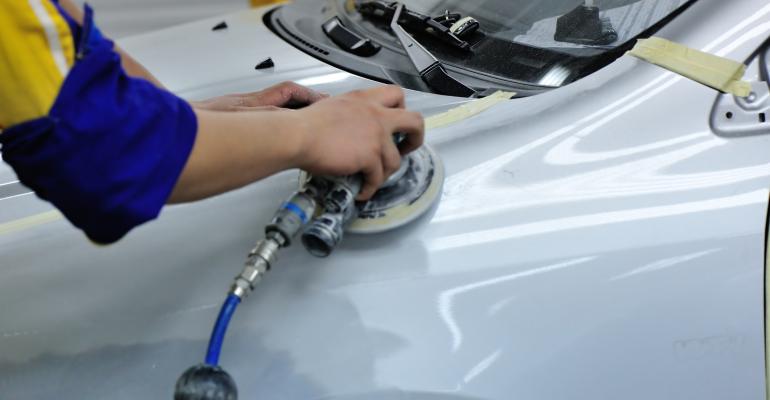Collision repair isn’t a service immediately associated with a dealership, but around a third of franchised dealerships have body shops, according to National Auto Dealers Assoc.
Consultants and dealers say collision repair can be profitable, but it’s not for the faint of heart.
“I feel like dealerships are missing out on an incredible opportunity to have their own body shop,” Mike Anderson, owner and president of Collision Advice, a consultancy, tells WardsAuto.
Anderson, who worked in collision repair for more than two decades, sees at least four reasons a dealership should establish a body shop:
- To protect the franchise brand
- To sell more wholesale parts
- To drive more new car sales
- To boost business in the service lane
Another good reason to be in the collision repair business is to boost the dealership’s bottom line. Body shops are making up to 48% gross profit, Anderson says, and the average repair is $5,000. “Do the math,” he says. “The business case is there to justify the investment.”
The Tamaroff Auto Group’s two collision centers are profitable, Group president Eric Frehsée tells WardsAuto. The Michigan-based group’s collision center technicians at its Michigan-area Honda stores in Southfield and Roseville work on all brands of vehicles and are certified by American Honda.
The collision centers allow the group to keep the customer with it for a vehicle’s entire life cycle, he says. Besides repairing a customer’s vehicle, Tamaroff works with insurance companies and even has rental cars on-site, making the process seamless.
“From a convenience and comfort standpoint, customers have a lot of choices where to buy their car,” Frehsée says. “One added feature you can supply them with is fixing their car.”
Tamaroff’s collision centers are certified by American Honda Motor Co.. Manufacturer certification indicates a collision center provides a certain standard of service, uses manufacturer-certified parts, and has technicians who have received manufacturer-certified training.
While the certification boosts customer confidence, the number one benefit, Anderson says, is “you will get access to their factory (technician) training.”
Helping with the service absorption rate
Diehl Auto Group’s eight collision centers contribute to new car sales and are a source of new customers, Matt Whittenberger, the group’s fixed ops director, tells WardsAuto. Five of the collision centers are attached to dealerships; three were independent body shops the group acquired, he says. Seven are in Pennsylvania and one is in Ohio.
The collision centers are seeing a record number of damaged vehicles declared total losses by insurance firms because of their high salvage value and the high repair cost. That results in new car sales and new customer acquisition, Whittenberger says..
“We are flipping these customers over to the sales department and helping them get a new vehicle,” he says.
The dealership also gains a new customer when a collision center customer who had not previously bought a new vehicle from Diehl has a car totaled. “Now they are our (new car) customer,” Wittenberg says. “It is a really big benefit.”
Another “huge benefit” of the collision centers is parts sales, he says. “We sell about $1 million in parts to ourselves every month.”
A dealership’s service department often handles some collision repair work, says consultant Anderson, especially those related to repair and calibration electronic systems such as Advanced-Driver Assistance Systems (ADAS).
“This will help with the (service) absorption rate,” Anderson says, referring to the percentage of a dealership’s gross operating expenses covered by the service and parts department.
Barriers to entry
About 34% of franchised dealerships in the U.S., or around 5,700, have collision centers, Patrick Manzi, NADA chief economist, tells WardsAuto. The percentage of dealerships offering collision repair has remained flat over the last few years, he adds.
One limiting factor in opening a collision center is the shortage of collision repair technicians. His body shops are profit centers, Frehsée says. “Where the challenge is, is recruiting (collision repair) techs. It is really hard to find bodymen. The younger generation want to go into mechanical repairs.”
Getting into the collision repair business also requires a significant upfront investment for a dealership, though the amount will vary based on the manufacturer, consultant Anderson says. Adding a collision repair shop for a European luxury brand is much more expensive than for an Asian or domestic brand, he explains.
That’s due to the high cost of real estate in some areas and collision repair equipment that costs millions of dollars, Frehsée says. Then there’s the training and certification costs. The competition with independent body shops is tough for smaller dealerships to handle, he says.
“I probably wouldn’t start with a body shop today,” Frehsée says. “There are definitely barriers for entry.”
Diehl’s Whittenberger sees it differently. He started with the Diehl group, managing one of its collision centers, then two, and then all fixed operations. He knows the collision center expense structure, the amount of sales it takes to cover expenses, and where to find new business, Whittenberger says.
“If I was a dealer owner, I could understand why someone could be afraid of (opening a collision center,) but knowing what I know, I would be very confident from day one,” he says.




